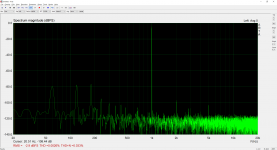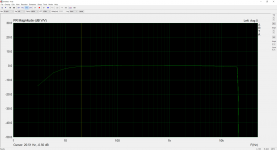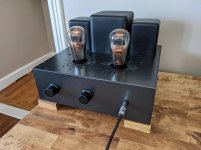Thanks, euro21, I had back-to-back zeners in the original design, however Rod suggested removing the second (post #6).
Seems I may have misunderstood my reading on the benefits of a drain resistor, I am still learning. If removing that resistance shows some improvement, I may do one final iteration of the SF boards, but this time with the C2M1000170D once again with TO-247 pinout. Perhaps I will try your cascode suggestion as well.
I have tried the mu-output of the 841 CCS, to be honest I did not hear much difference at the time and HF response was unchanged given the source follower, but I am likely to try it once again now that some changes have been made!
Seems I may have misunderstood my reading on the benefits of a drain resistor, I am still learning. If removing that resistance shows some improvement, I may do one final iteration of the SF boards, but this time with the C2M1000170D once again with TO-247 pinout. Perhaps I will try your cascode suggestion as well.
I have tried the mu-output of the 841 CCS, to be honest I did not hear much difference at the time and HF response was unchanged given the source follower, but I am likely to try it once again now that some changes have been made!
I gave the circuit a listen for some time with the changes I made and after the ear/brain adjustment, something still was not right. Strident treble, small soundstage, I suspected continued HF issues although I had no concrete measurements to prove it. I made some changes without improvement, including removal of the AOTN160 drain resistor and coupling the low Z DN2540 source output of the cascode CCS to the source follower input.
I decided to give the Cree C2M1000170D another shot with proper HF decoupling, ferrite bead as recommended by Cree with my new SF board layout. I put a 10ohm carbon comp resistor on the drain, an NiZn ferrite bead on the gate. I left the low Z output of the CCS as it was.
Happy to say the stridency is gone, the sound is much improved, very enjoyable, large soundstage and non-fatiguing, great transparency. Time for more brain adjustment, but I think I've gotten right this time.
Here is a 1.1mW FFT into a 300ohm dummy with the high-Z output with RCA globe 841. Low frequency noise is due to coupling from filament supply AC to the signal input wiring, which I will be working to improve next. Distortion is quite low.

Here is the frequency response into 300ohm dummy high-Z output.

Will give it a long listen today, so far so good 🙂

I decided to give the Cree C2M1000170D another shot with proper HF decoupling, ferrite bead as recommended by Cree with my new SF board layout. I put a 10ohm carbon comp resistor on the drain, an NiZn ferrite bead on the gate. I left the low Z output of the CCS as it was.
Happy to say the stridency is gone, the sound is much improved, very enjoyable, large soundstage and non-fatiguing, great transparency. Time for more brain adjustment, but I think I've gotten right this time.
Here is a 1.1mW FFT into a 300ohm dummy with the high-Z output with RCA globe 841. Low frequency noise is due to coupling from filament supply AC to the signal input wiring, which I will be working to improve next. Distortion is quite low.

Here is the frequency response into 300ohm dummy high-Z output.

Will give it a long listen today, so far so good 🙂

Last edited: